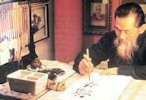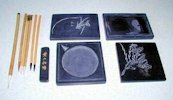| 7. Chinese Calligraphy | |||

|

|

|
Return to Chinese Language Choices
On to Dialects 8 ⇨ |
| "By Order of the Emperor" | Chinese Calligrapher | Brushes, Ink, and Ink-stones | |
|
Writing the characters of Chinese script has become a major art form in China, where people revere traditional literacy and learning. A calligrapher utilizes the same tools and techniques as a painter. The calligrapher chooses his brush, ink ink-stone, and paper (the scholar's Four Treasures") and stands over an empty scroll imagining how best to arrange the text of a poem or quotation on the available space. Emotion and elegance go into the brushstrokes of each character, whether written in precise classical form, in running style that looks deceptively spontaneous, or in one of the many other styles developed over the centuries. Calligraphy has long been regarded as an art in its own right in China. Traditional aesthetic theory has valuated individual brush strokes according to four Qualities, which should be perfectly balanced in flawless writing:
|
|||